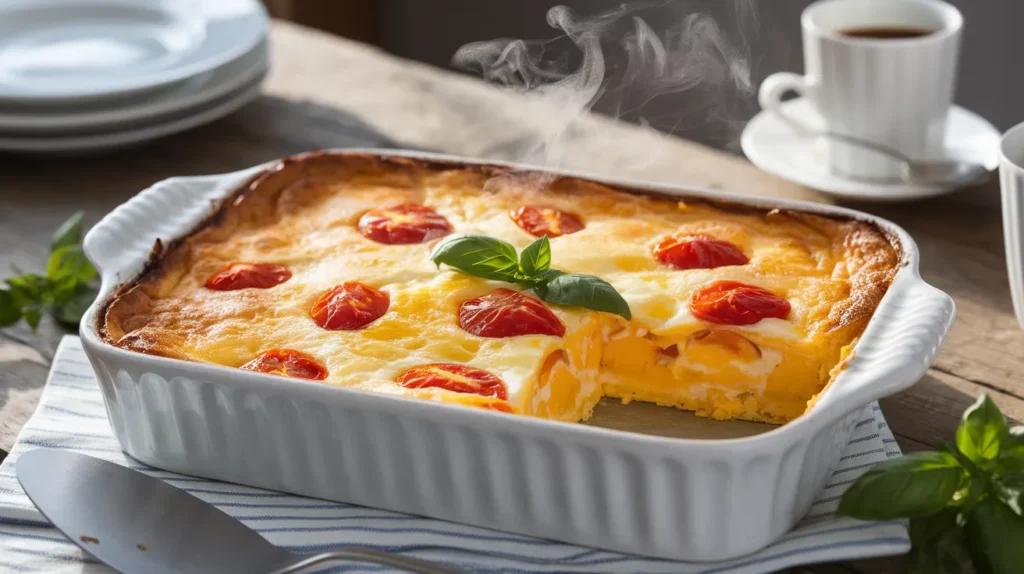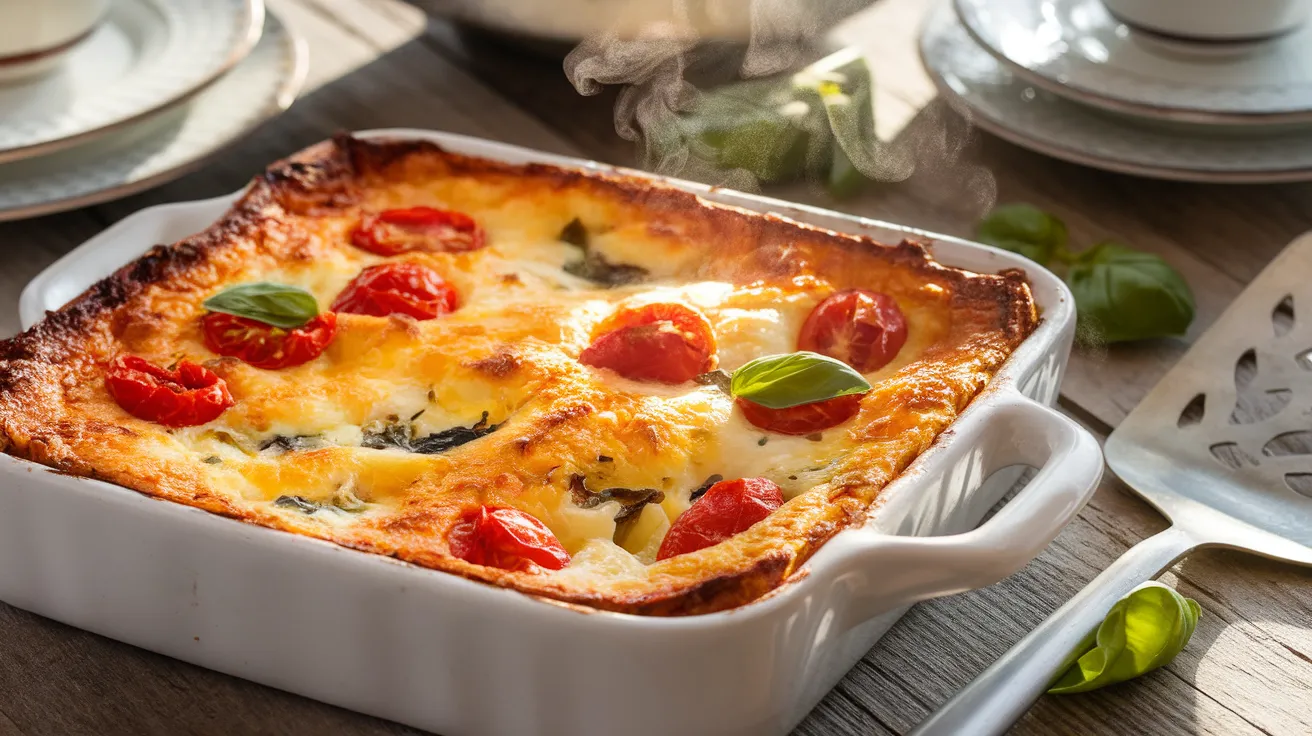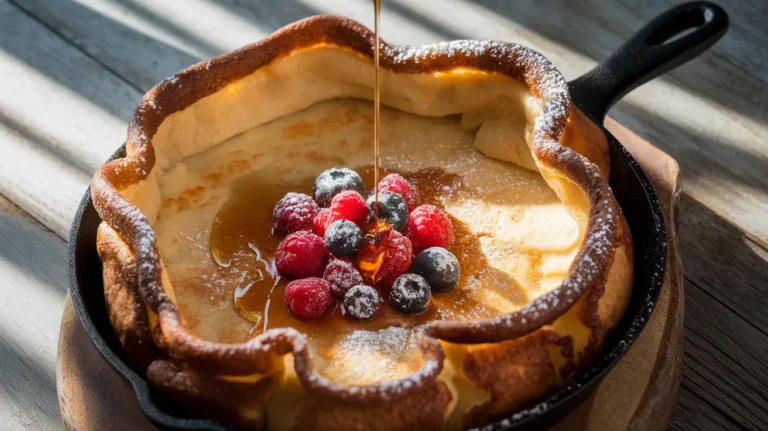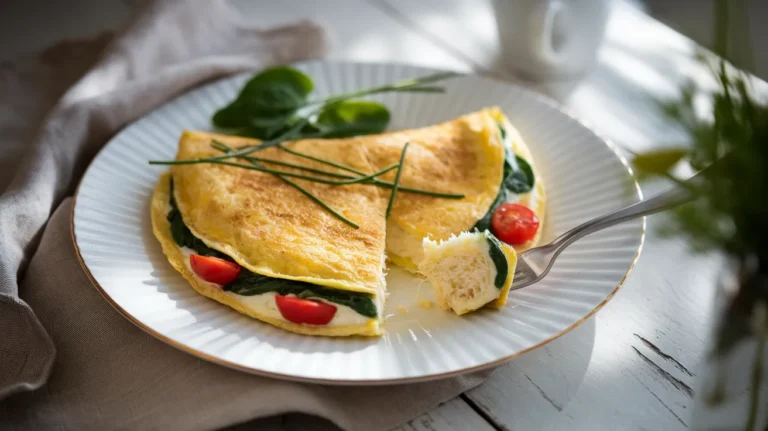Discover the creamy, protein-packed ricotta egg casserole that’s about to become your family’s weekend breakfast obsession. This foolproof dish combines velvety ricotta cheese with perfectly baked eggs for a restaurant-quality meal that takes just minutes to prep.
SERVES: 4 | PREP: 15 MIN | COOK: 35 MIN | TOTAL: 50 MIN
Why This Ricotta Egg Casserole Works
This isn’t just another breakfast casserole. The ricotta creates an incredibly creamy texture that regular egg bakes can’t match. The secret lies in the cheese-to-egg ratio that keeps everything moist without being runny.
You’re getting a high-protein breakfast that actually tastes indulgent. Each serving packs serious nutrition while delivering comfort food vibes.
Ingredients You’ll Need
Dairy & Eggs
| Ingredient | Amount |
|---|---|
| Whole milk ricotta cheese | 2 cups |
| Large eggs | 8 |
| Heavy cream | ½ cup |
| Parmesan cheese, grated | ½ cup |
| Mozzarella cheese, shredded | 1 cup |
Seasonings & Aromatics
| Ingredient | Amount |
|---|---|
| Fresh garlic, minced | 3 cloves |
| Fresh basil, chopped | ¼ cup |
| Salt | 1 teaspoon |
| Black pepper | ½ teaspoon |
| Red pepper flakes | ¼ teaspoon |
Add-Ins (Optional)
| Ingredient | Amount |
|---|---|
| Baby spinach, chopped | 2 cups |
| Cherry tomatoes, halved | 1 cup |
| Cooked Italian sausage | ½ pound |
Step-by-Step Instructions
Phase 1: Preparation (5 minutes)
Step 1: Preheat your oven to 375°F and position the rack in the center. Why this temperature? It’s hot enough to set the eggs without browning the top too quickly.
Step 2: Generously butter a 9×13 inch baking dish, making sure to coat the corners. Pro tip: Use room temperature butter for easier spreading.
Step 3: Let your ricotta sit at room temperature for 10 minutes if it’s been refrigerated. Cold ricotta won’t blend as smoothly with the eggs.
Phase 2: Building the Base (8 minutes)
Step 4: Crack all 8 eggs into a large mixing bowl and whisk vigorously for 30 seconds. You want them completely uniform with no visible egg whites.
Step 5: Add the ricotta cheese in three additions, whisking thoroughly after each. Common mistake warning: Dumping all the ricotta at once creates lumps that won’t smooth out.
Step 6: Pour in the heavy cream and continue whisking until the mixture looks like thick pancake batter. It should be pourable but substantial.
Step 7: Fold in the minced garlic, chopped basil, salt, pepper, and red pepper flakes. Taste the mixture now – it should be well-seasoned since eggs mute flavors when cooked.
Phase 3: Layering (7 minutes)
Step 8: Pour half the ricotta egg mixture into your prepared baking dish. Spread it evenly to the edges using a spatula.
Step 9: If using spinach, squeeze out ALL the water first, then scatter it over the base layer. Critical step: Wet spinach will make your casserole watery and sad.
Step 10: Distribute the cherry tomatoes evenly, pressing them gently into the mixture. They’ll release moisture during baking, adding flavor pockets.
Step 11: Pour the remaining ricotta egg mixture over your add-ins, ensuring even coverage. Give the dish a gentle shake to help it settle into all the gaps.
Phase 4: The Cheese Crown (2 minutes)
Step 12: Sprinkle the Parmesan cheese evenly across the entire surface. This creates a golden, crispy top layer.
Step 13: Add the shredded mozzarella in an even layer over the Parmesan. Visual cue: You should barely see the mixture underneath – cheese is your friend here.
Phase 5: Baking (35 minutes)
Step 14: Place the casserole on the center rack and set a timer for 25 minutes. Don’t open the oven door during this time – you’ll lose heat.
Step 15: After 25 minutes, check for the “jiggle test” – the center should wobble slightly when you shake the dish. If it’s still very liquid, bake for 5 more minutes.
Step 16: The ricotta egg casserole is done when the edges are golden brown and the center jiggles like firm Jell-O. Temperature check: An instant-read thermometer should register 160°F in the center.
Phase 6: Resting & Serving (10 minutes)
Step 17: Remove from the oven and let rest for exactly 10 minutes before cutting. This resting time lets the eggs finish cooking from residual heat.
Step 18: Cut into 4 generous squares and serve immediately with fresh basil on top. The cheese will still be melty and gorgeous.
Chef’s Notes
Timing is Everything: The casserole continues cooking after you remove it from the oven. Slightly underdone is better than overdone – you want creamy, not rubbery.
Cheese Selection Matters: Full-fat ricotta makes this recipe sing. Low-fat versions create a watery, grainy texture that ruins the luxurious mouthfeel.
Make It Ahead: Assemble the entire ricotta egg casserole the night before, cover tightly, and refrigerate. Add 10 minutes to the bake time.
Leftover Magic: This reheats beautifully for up to 4 days. Wrap individual portions in foil and warm at 325°F for 15 minutes.
Nutrition Information (Per Serving)
| Nutrient | Amount |
|---|---|
| Calories | 485 |
| Protein | 32g |
| Carbohydrates | 8g |
| Fat | 36g |
| Fiber | 1g |
Creative Variations
Mediterranean Style
Replace Italian sausage with sun-dried tomatoes, kalamata olives, and crumbled feta. Add oregano instead of basil for an authentic Greek flavor.
Mushroom Lovers
Sauté cremini mushrooms with thyme until golden, then fold them into the mixture. The earthy flavors complement the ricotta beautifully.
Southwestern Twist
Add black beans, corn, diced green chiles, and swap the basil for cilantro. Top with pepper jack cheese for a spicy kick that rivals our ricotta egg muffins.
Veggie Loaded
Pack in zucchini, bell peppers, and caramelized onions. This version works perfectly for brunch gatherings and pairs wonderfully with ricotta egg bites.
Storage & Reheating Guide
Refrigerator Storage: Cover tightly with plastic wrap or transfer to an airtight container. Keeps for 4-5 days.
Freezing Instructions: Cut into individual portions, wrap each piece in plastic wrap, then foil. Freeze for up to 2 months.
Reheating from Frozen: Thaw overnight in the refrigerator. Reheat at 325°F for 20 minutes or microwave individual portions for 2-3 minutes.
Best Reheating Method: Cover with foil and warm in a 325°F oven for 15 minutes. The foil prevents the top from over-browning while the inside heats through.

Troubleshooting Common Problems
Problem 1: Watery Casserole
Solution: You likely didn’t drain your vegetables properly. Always squeeze excess water from spinach and pat tomatoes dry. Also, avoid using skim milk ricotta.
Problem 2: Rubbery Texture
Solution: You overbaked it. Remember, the casserole continues cooking during the resting period. Pull it when there’s still a slight jiggle.
Problem 3: Eggs Won’t Set
Solution: Your oven temperature might be off. Use an oven thermometer to verify accuracy. Also, make sure you’re using the right size baking dish – too large means too thin.
Problem 4: Burnt Top, Raw Center
Solution: Cover loosely with foil after 20 minutes of baking. Lower your oven rack one position for more even heat distribution.
Problem 5: Bland Flavor
Solution: Season generously before baking – eggs need more salt than you think. Add a pinch of nutmeg to enhance the cheese flavors.
Equipment Essentials
- 9×13 inch baking dish (ceramic or glass works best)
- Large mixing bowl (at least 3-quart capacity)
- Whisk (balloon style preferred)
- Rubber spatula (for folding and scraping)
- Instant-read thermometer (optional but helpful)
- Sharp knife (for clean cutting)
- Box grater (if grating cheese fresh)
Shopping List Organization
Dairy Section
- 2 cups whole milk ricotta
- 8 large eggs
- ½ cup heavy cream
- ½ cup Parmesan cheese
- 1 cup mozzarella cheese
Produce Section
- 3 garlic cloves
- Fresh basil bunch
- Optional: spinach, cherry tomatoes
Spice Aisle
- Red pepper flakes (if needed)
Meat Counter (Optional)
- Italian sausage
5 Success Secrets
1. Room Temperature Ingredients Take your eggs and ricotta out 30 minutes before starting. Cold ingredients create a lumpy mixture and uneven cooking.
2. The Whisking Technique Whisk eggs until completely uniform before adding ricotta. This prevents white streaks in your final casserole.
3. Don’t Skip the Rest That 10-minute rest after baking isn’t optional. It’s when the magic happens – the eggs set perfectly and the flavors meld.
4. Layer Strategically Keep wet ingredients like tomatoes in the middle layer. Putting them on top creates soggy spots.
5. Trust the Jiggle The center should jiggle like barely-set custard when done. It firms up during resting. Pull it too late and you’ll have rubber eggs.
This ricotta egg casserole delivers restaurant-quality breakfast without the hassle. The creamy texture from the ricotta cheese combined with perfectly baked eggs creates something special that your family will request every weekend. Make it once and you’ll understand why it’s become a breakfast staple in kitchens everywhere.




